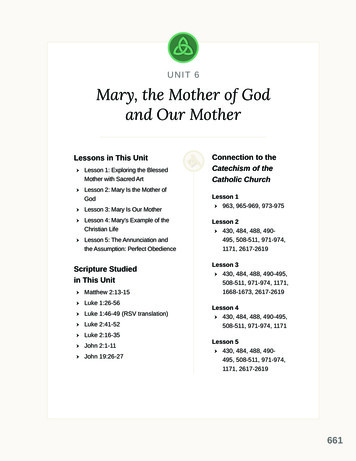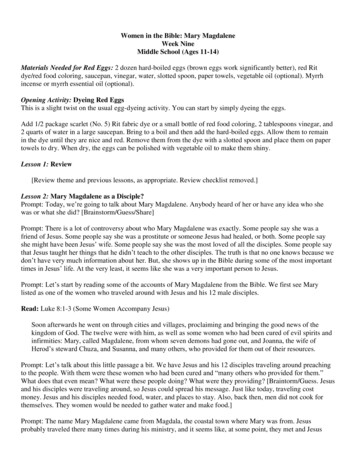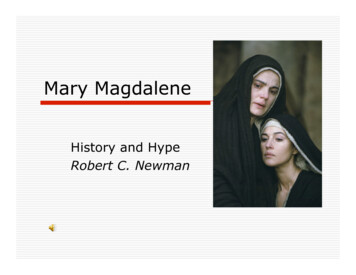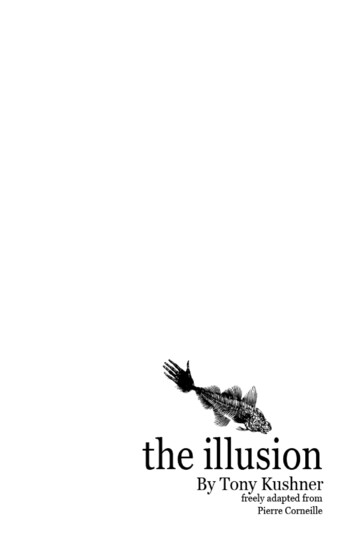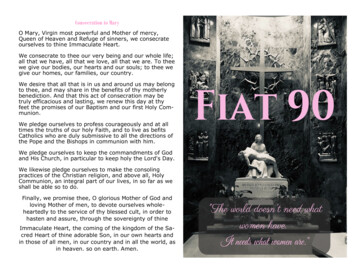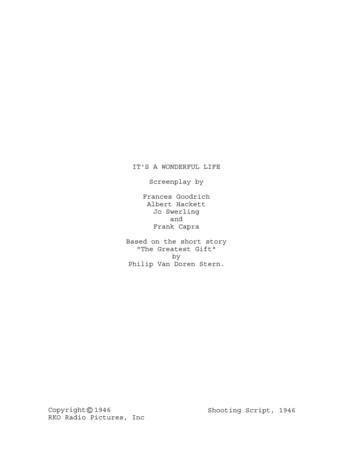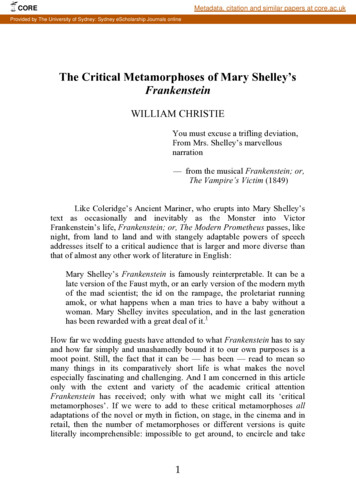
Transcription
COREMetadata, citation and similar papers at core.ac.ukProvided by The University of Sydney: Sydney eScholarship Journals onlineThe Critical Metamorphoses of Mary Shelley’sFrankensteinWILLIAM CHRISTIEYou must excuse a trifling deviation,From Mrs. Shelley’s marvellousnarration— from the musical Frankenstein; or,The Vampire’s Victim (1849)Like Coleridge’s Ancient Mariner, who erupts into Mary Shelley’stext as occasionally and inevitably as the Monster into VictorFrankenstein’s life, Frankenstein; or, The Modern Prometheus passes, likenight, from land to land and with stangely adaptable powers of speechaddresses itself to a critical audience that is larger and more diverse thanthat of almost any other work of literature in English:Mary Shelley’s Frankenstein is famously reinterpretable. It can be alate version of the Faust myth, or an early version of the modern mythof the mad scientist; the id on the rampage, the proletariat runningamok, or what happens when a man tries to have a baby without awoman. Mary Shelley invites speculation, and in the last generation1has been rewarded with a great deal of it.How far we wedding guests have attended to what Frankenstein has to sayand how far simply and unashamedly bound it to our own purposes is amoot point. Still, the fact that it can be — has been — read to mean somany things in its comparatively short life is what makes the novelespecially fascinating and challenging. And I am concerned in this articleonly with the extent and variety of the academic critical attentionFrankenstein has received; only with what we might call its ‘criticalmetamorphoses’. If we were to add to these critical metamorphoses alladaptations of the novel or myth in fiction, on stage, in the cinema and inretail, then the number of metamorphoses or different versions is quiteliterally incomprehensible: impossible to get around, to encircle and take1
Sydney StudiesCritical Metamorphoses of Frankensteinin. Mary Shelley’s older contemporary, the literary satirist ThomasMathias observed that Gothic novels ‘propagated their species withunequalled fecundity’ and left their ‘spawn’ in every bookshop, but MaryShelley’s creation has spawned with a Malthusian menace of whichMathias could not even have conceived.2 Indeed, we cannot conceive of it.Already, for example, it is quite simply impossible for any one individualto pursue every reference to ‘Frankenstein’ on the internet in his or herlifetime. The forms these metamorphoses have taken, the degree offamiliarity with the original story they betray, have varied enormously.3Still, however, they can all be said to have originated in Mary Shelley’snovel of 1818 or its revised edition of 1831.In literary criticism and literary history, as it happens, this restlessmetamorphosis has not always been the case. Popularizations and parodieshave continued unabated since Presumption; or, The Fate of Frankensteintook to the London stage in July 1823,4 but until thirty years agoFrankenstein drew from literary critics only an occasional, parentheticalreference to its well-meaning ineptitude. Frankenstein was cited as ‘aninteresting example of Romantic myth-making, a work ancilliary to suchestablished Promethean masterpieces as Shelley’s Prometheus Unboundand Byron’s Manfred’, to quote Sandra Gilbert and Susan Gubar, andMary Shelley herself only acknowledged because of the ‘literary/familialrelationships’ she represented.5 Gilbert and Gubar may well have had inmind Harold Bloom’s influential visionary hierarchy:what makes Frankenstein an important book, though it is only astrong, flawed novel with frequent clumsiness in its narrative andcharacterization, is that it contains one of the most vivid versions wehave of the Romantic mythology of the self, one that resemblesBlake’s Book of Urizen, Shelley’s Prometheus Unbound and Byron’sManfred, among other works. Because it lacks the sophistication andimaginative complexity of such works, Frankenstein affords a uniqueintroduction to the archetypal world of the Romantics.6By saying badly what the canonical male Romantic poets were sayingwell, Frankenstein was thought to function at once to justify theircanonization and to illuminate the otherwise difficult, self-reflexiveenterprise of Romanticism. Where Blake and Shelley and Byron wrote ofRomanticism from the vexed inside, that is, Mary Shelley offered whatwas at best a simplified version from the outside, at worst ‘a passive2
Sydney StudiesCritical Metamorphoses of Frankensteinreflection of some of the wild fantasies which, as it were, hung in the air7about her’ (Mario Praz) . ‘Like almost everything else about her life,Frankenstein is an instance of genius observed and admired but not8shared’, according to Robert Kiely; ‘one of those second-rate works’,declared D. W. Harding, ‘written under the influence of more9distinguished minds’.Thanks largely to some Copernican changes in our critical universe,Mary Shelley’s Frankenstein now has a reputation commensurate with thelooming bulk of its own Monster, having been unofficially canonized bythe sheer variety and extent of interpretative activity that it has inspiredover the last thirty years. This article offers a critical map of that activity,asking what in its nature and extent it might have to say aboutFrankenstein itself, as well as about the critical conditions under whichMary Shelley’s novel has gone forth and multiplied.II have said that Frankenstein has spawned a literallyincomprehensible number of different interpretations. For all that,however, and especially amongst a general public apprized of the myth butinnocent of the novel, there remains a remarkable consensus — as MarilynButler points out: ‘Readers, filmgoers, people who are neither, take thevery word Frankenstein to convey an awful warning: don’t usurp God’sprerogative in the Creation-game, or don’t get too clever with10technology’.God’s prerogative; Nature’s prerogative; History’sprerogative; the prerogative of the conservative, self-correcting principlesinternal to Evolution — the precise providential scheme is less importantthan its self-licensed priority and the sense of violation offered byexperiments like Victor Frankenstein’s. This understanding by the generalpublic of the Frankenstein myth as a fable of technologico-scientificirresponsibility — from the Monster as ‘a simulacrum of industrialized1112reproduction’ to nuclear physics and biological cloning — is one of tworeadings which literary criticism has been content to share, even to take forgranted. ‘The Monster’, Martin Tropp reminds us, ‘has been called theancestor of “all the shambling horde of modern robots and androids” inscience-fiction’, while Frankenstein has engendered ‘a whole range ofdemented scientists, from Dr Strangelove to the Saturday morning cartoonmadmen whose symptoms include unruly hair, a persistent cackle, and the3
Sydney StudiesCritical Metamorphoses of Frankensteindesire to (dare I say it?) “rule the world!” ’: ‘Mad scientist and monster arefigures in a modern myth; they reflect our fears about the future of man in13a world of machines’.Since 1980 Frankenstein has been resituated along with all theother literature of the Romantic period by New and old forms ofhistoricism in a progressively more detailed recreation of the complex andinterrelated cultures of that period. And this is nowhere more apparentthan with the culture of the experimental and theoretical sciences of theeighteeenth and early nineteenth centuries. The general scientific‘background’ to Frankenstein is explored at length in a monograph bySamuel Vasbinder and in Anne Mellor’s discussion of the novel as ‘AFeminist Critique of Science’: ‘Mary Shelley based Victor Frankenstein’sattempt to create a new species from dead organic matter through the useof chemistry and electricity on the most advanced scientific research of theearly nineteenth century. Her vision of the isolated scientist discoveringthe secret of life is no mere fantasy but a plausible prediction of what14science might accomplish’. Moving beyond Mellor’s more abstractapproach to the history and philosophy of science, however — on theconviction that (to quote Marilyn Butler) ‘the academic reading-list needsqualifying or replacing with a form of newspaper and journal-talk which15could be thought of as current language’ — many recent essays havefocussed more intensively on Mary Shelley’s and the novel’s relation tothe immediate discoveries and controversies of the contemporary scientificworld:The fluid boundary between death and life — a dominant theme in thebio-medical sciences of this time — was of such importance thatFrankenstein imagined that, in time, he might be able to ‘renew lifewhere death had apparently devoted the body to corruption’. Thebelief that the boundary between life and death was reversible waswidely held at the time, indeed for most of the eighteenth centurythere had been sustained interest in suspended animation, techniquesfor reviving the drowned and the hanged, premature burial — indeedin any aspect of medicine that held out the hope that death could bedelayed, avoided, held at bay. Medical writers imagined doctors in a16quasi-divine role, shedding new light on nature’s processes.Ludmilla Jordanova, from whom I quote, reads into Victor Frankenstein’sresearches and attitude ‘the fantasies of (at least some) medical4
Sydney StudiesCritical Metamorphoses of Frankensteinpractitioners of the time’ — ‘a new breed of metropolitan medical men’ —and their struggle to create ‘a culture of medical and scientific power’ as‘one way of securing power itself’. To highlight the issue of the socialpathology of the profession and relate it to the critical preoccupation withthe ‘birth myth’ in Frankenstein that I discuss below, Jordanova focusses17her discussion on the controversy of ‘man midwifery’. Butler, on theother hand, traces more narrowly the flux and reflux of ‘the vitalist debate’over the years of the novel’s intellectual gestation, concentrating on theShelleys’ relationship with one of its more articulate participants, WilliamLawrence, and showing how the very language of this often personal and18always political debate enters the novel.One thing that becomes increasingly apparent the closer thatscholarship brings us to Regency Britain, especially to the hybrid ‘science’of medical practice and its day to day, often ad hoc procedures, is that anyline drawn between the Gothic on the one hand, and the theory andpractice of the empirical sciences in the early nineteenth century on theother, must remain tentative. The title of Tim Marshall’s recent study saysit all: Murdering to Dissect: Grave-Robbing, Frankenstein, and the19Anatomy Literature. The closer we come to such historical phenomenaas the 1832 Anatomy Act, in other words, the more history, both as thepast itself and as a narrative of the past, becomes a Gothic genre. And theGothicization of history — in this case the teaching and practice ofanatomy and surgery — serves simultaneously to de-Gothicize episodeslike the following in Frankenstein:Now I was led to examine the cause and progress of this decay, andforced to spend days and nights in vaults and charnel houses. Myattention was fixed upon every object the most insupportable to thedelicacy of the human feelings. I saw how the fine form of man wasdegraded and wasted; I beheld the corruption of death succeed to theblooming cheek of life; I saw how the worm inherited the wonders ofthe eye and brain. I paused, examining and analysing all the minutiæof causation, as exemplified in the change from life to death, anddeath to life, until from the midst of this darkness a sudden light brokein upon me . . . (p. 35)So it is with the many other, less sensational studies that similarly move todemystify the text — in literary terms, to de-Romanticize it — by bringingit back into a precisely unsensational relation to the social and political5
Sydney StudiesCritical Metamorphoses of Frankensteinquotidian. The point they make and remake is the point that Mary Shelleyherself stressed in her 1831 introduction, that invention ‘does not consistin creating out of void’; that ‘the materials must, in the first place, be20afforded’.Of the revolutions effected in our understanding ofFrankenstein over the last thirty years, this move to demystify the story byrefiguring it within the rich context of those historical materials that wereafforded may well prove, because of historicism’s own ‘empirical’methodology, the most lasting.Though at a cost, it seems to me. Victor Frankenstein may beneither archetype nor psychopath and may have shared his arrogance andresearches with a number of Mary Shelley’s contemporaries — after all,the ‘projectors’ in Swift’s Academy of Lagado were carrying outexperiments that had been performed by members of the Royal Society.But Mary Shelley’s Monster, like Swift’s Laputans, steps out of anotherimaginative realm altogether, and this in spite of all the authentic wild,unnurtured and untutored ‘noble savages’ that roamed the pages ofEnlightenment speculation on psychology and education. Jordanovaprotests defensively that she is ‘not claiming for Frankenstein some kindof “documentary” status it does not possess’, but in doing so betrays thedanger of an historical reconstruction so thoroughgoing that the textdisappears into the material conditions that produced it or thereconstruction itself becomes nothing more than a theoreticallysophisticated search for sources and analogues. It is one thing to attend toFrankenstein’s running argument with contemporary reviewers andanother thing to allow it ‘to speak to the mysterious fears of our nature,and awaken thrilling horror’ as Mary Shelley certainly hoped it would (p.195).IIThe other interpretation literary critics have been content to sharewith the general public is of Frankenstein as a political fable, a readingthat became idiomatic soon after publication and one that dominated21nineteenth-century usage. ‘Like her father’, writes biographer WilliamSt Clair, Mary Shelley ‘provided a metaphor for the upheavals of the age.The phrase “to create a Frankenstein monster” was to become a22nineteenth-century political cliché’. In this, the Monster is seen either asa composite symbol of the lower classes or, more often, as symbolizing an6
Sydney StudiesCritical Metamorphoses of Frankensteinhistorically specific, especially unruly section of the lower classes turningthreateningly on their social superiors. The poet Shelley exonerated therevolutionary psychology while revealing the allegorical key to this familyof readings in a review of Frankenstein that remained unpublished in hislifetime:nor are the crimes and malevolence of the single Being, though indeedwithering and tremendous, the offspring of any unaccountablepropensity to evil, but flow irresistably from certain causes fullyadequate to their production. They are the children, as it were, ofNecessity and Human Nature. In this the direct moral of the bookconsists, and it is perhaps the most important and of the mostuniversal application of any moral that can be enforced by example —Treat a person ill, and he will become wicked. Requite affection withscorn; let one being be selected, for whatever cause, as the refuse ofhis kind — divide him, a social being, from society, and you impose23upon him the irresistable obligations — malevolence and selfishnessFor Shelley’s and subsequent radical readings, monstrous intimidationfollows necessarily from equally monstrous and dehumanizing neglect. ‘“Oh, Frankenstein” ’, protests the Monster to his maker, ‘ “be notequitable to every other, and trample upon me alone, to whom thy justice,and even thy clemency and affection, is most due. Remember, that I amyour creature: I ought to be thy Adam, but I am rather the fallen angel,whom thou drivest from joy for no misdeed” ’ (pp. 77-8).In the bulk of historico-political readings, Frankenstein ‘is24traversed with the images and effects of the French Revolution’. LeeSterrenberg, for example, cites intriguing detail like Mary Shelley’schoice, in Ingolstadt, of a place that had been identified in the AbbéBarruel’s Memoirs Illustrating the History of Jacobinism (1797) and byThomas Robison in his Proofs of a Conspiracy (1798) as the home of asecret society called Illuminati and thus as the intellectual cradle of the25French Revolution.Chris Baldick, on the other hand, traces theaccusation of monstrosity back and forth between anti-Jacobin and Jacobinthroughout the revolution controversy of the 1790s. Frankenstein is seento participate in the battle for rhetorical supremacy instigated by ‘themonster image’ of filial ingratitude ‘organizing, understanding, and at thesame time preserving the chaotic and confused nature of the revolutionaryevents’ in Edmund Burke’s account in his Reflections on the Revolution in7
Sydney StudiesCritical Metamorphoses of Frankenstein26France (1790).Finally, Marie Roberts discovers an allegoricalspecificity, not in the historical origins of the novel, but in the politicaltheory it proposes: ‘The dialectic between Victor and the monster may beunderstood in terms of Marx’s theory of alienation, part of which concernsmankind’s alienation from the product of its labour, seen in theestrangement of the monster from his maker. The ceature has thecharacteristics of both worker and product, having been negated and27alienated by capitalist society’.Whether Frankenstein is interpreted as a Rousseauistic myth ofinnocence corrupted by society or — anachronistically, as in Roberts’scase — as a political economic myth of industrial capitalist expansion,socio-political readings are often seemlessly combined with readings ofthe novel as an allegory of the dangers of scientific-technologicalproduction out of control. The historical paradigms here were themachine-breaking Luddite uprisings in Nottinghamshire and the North,‘and the Pentridge uprising of 1817’, revolts that according to PaulO’Flinn pressed directly on the Shelley-Byron circle and are figured in theclash between Frankenstein and his Monster. ‘The strength in the text’, forO’Flinn, is its sense of ‘the impact of technological developments on28people’s lives and the possibility of working-class revolution’. This maybe amongst the things Ann Mellor has in mind when she says that Mary29Shelley ‘initiated a new literary genre, what we now call science fiction’,for the same fear of mechanization out of control informs the typicalscience-fiction dystopia of our own century: a sinister scientifictechnocracy whose success is built upon the marginalization and attempteddehumanization of the mass of the people — in 1984, for example, andHuxley’s Brave New World through to the more recent cyberspaceequivalents of William Gibson.Like those readings that exhume the front-page scientists andmedical practioners of the time, political readings come most commonlyfrom the historicists. In its determination to restore the text to the cultureout of which it emerged, historicism reacts against any tendency to readthe text as a universal myth, a tendency it identifies as (irresponsibly)Romantic. Two difficulties with historico-political readings ofFrankenstein are worth mentioning before we leave them, however —besides the one I mentioned earlier of substituting for the text theconditions of its production. The first is one of evidence — not a lack, buta surfeit of evidence. Moves to read the text back into its specific context8
Sydney StudiesCritical Metamorphoses of Frankensteincan always find ample objects and occasions, given that in any periodthere is more going on than we can ever assimilate and organizehistorically. In the early nineteenth century this was, if anything, onlymore urgently and self-consciously the case. The fact that the Shelleysand the Godwins were argumentatively and actively engaged incontemporary political and print culture makes little that was said anddone during the period irrelevant to a genetics of Frankenstein. Not only iscriticism obliged to offer evidence, then, but it is obliged to offer it in theface of the wealth of potentially relevant material that it has more or lessconsciously excluded from consideration.There is an interesting moment in Gilbert’s and Gubar’s TheMadwoman in the Attic in which a parenthetical attempt is made todetermine the significance of the choice of ‘William’ for the name ofVictor Frankenstein’s murdered brother: his ‘name is that of MaryShelley’s father, her half brother, and her son so that one can hardly decide30to which male relative she may have been alluding’. Gilbert and Gubarmight have thrown in any number of Mary Shelley’s friends, a handful ofwell known poets, and a huge percentage of the other males in a countrywhere ‘William’ was the most popular Christian name. While none of thisrules out the possibility of an allusion to one or more of the close relativesthey mention, it surely serves to discipline the impulse to leap at any echo,for significance of this kind requires stricter laws of probability thanFrankenstein is wont to invoke in its critics.The second difficulty has to do with ideology — the ideology ofthe author or the novel, that is, for the critic’s is less often in doubt.Where, exactly, does Frankenstein stand on the issue scientificexperimentation? — on the development of the medical profession? — onthe justice and significance of the French Revolution or the Ludditerevolts? — and so on. Rephrased as an issue of critical method, however,the reservation I am expressing concerns a tendency in socio-politicalreadings brilliantly and confidently to recreate the political culture andinvoke the contentious issues without asking how far the novel endeavoursto resolve them — and if it does so, how successful it is. Chris Baldick’sutterly convincing location of the language of monstrosity within thediscourse of revolution and reaction, for example, skirts the issue of whoseside Mary Shelley is on in the debate (he is comparatively uninhibited inhis characterization of Godwin’s position). So it is with many otherhistorical studies whose scholarship and critical relevance is never in9
Sydney StudiesCritical Metamorphoses of Frankensteinquestion. This reluctance to prosecute the enquiry may have something todo with the fact that the novel is more conservative than many of itsmodern academic critics are willing to admit. On the other hand, it mayexemplify the ‘uncertainty concerning the status of Mary Shelley as a selfconscious artist’ that Pamela Clemit identifies as ‘a feature of31Frankenstein criticism down to the present day’.IIIWe will return to the question of the variety and validity ofinterpretations of Frankenstein later. In the meantime, it is worthremarking how easily criticism has been able to politicize the Monster’spredicament as feminine, in spite of his nominal masculinity. For Gilbertand Gubar, for example, ‘the monster’s narrative is a philosophicalmeditation on what it means to be born without a “soul” or history, as wellas an explanation of what it feels like to be a “filthy mass that move[s] and32talk[s]”, a thing, an other, a creature of the second sex’ — that sex whichis not one, in Luce Irigaray’s terms. It is especially his ‘unique knowledgeof what it is like to be born free of history’ that is said to ally the Monsterwith those whose pasts have been effaced or repressed: the slave; the33colonized subject; the ‘nameless’ woman. But the book is a woman’sand feminism has no room for other oppressions: ‘Though it has beendisguised, buried, or miniaturized, femaleness — the gender definition ofmothers and daughters, orphans and beggars, monsters and false creators34— is at the heart of this apparently masculine book’. And certainly thecritical identification and exposition of the feminine preoccupations of thismale-dominated text have given rise to some of the best, most various andintriguing critical readings of Frankenstein over the last twenty-odd years.The mother of its feminist or female readings, Ellen Moers was thefirst to suggest that ‘Frankenstein is a birth myth, and one that was lodgedin the novelist’s imagination, I am convinced, by the fact that she washerself a mother’. The obsession with birth is said to derive in large partfrom Mary Shelley’s traumatic experiences of loss in child birth — first oflosing her mother, who died so soon after Mary Shelley’s own birth, thenof losing children of her own — as well as from her more generalknowledge of the potential dangers in pregnancy and giving birth faced bywomen at the time. But it is especially in Victor Frankenstein’s10
Sydney StudiesCritical Metamorphoses of Frankensteinabandonment of the Monster, writes Moers, ‘where Mary Shelley’s bookis most interesting, most powerful, and most feminine’:in the motif of revulsion against newborn life, and the drama of guilt,dread, and flight surrounding birth and its consequences. Most of thenovel, roughly two of its three volumes, can be said to deal with theretribution visited upon monster and creator for deficient infant care.Frankenstein seems to be distinctly a woman’s mythmaking on thesubject of birth precisely because its emphasis is not upon whatprecedes birth, not upon birth itself, but upon what follows birth: the35trauma of afterbirth.Again, as in the various political readings which are in truth socialversions of the same psychodrama, the most articulate in defence of thisinterpretation is the Monster himself: ‘ “Hateful day when I receivedlife!”, I exclaimed in agony. “Cursed creator! Why did you form amonster so hideous that even you turned from me in disgust?” ’ (p. 105).An often clear eyed and always eloquent interpreter speaking out of thenarrative centre of the novel, the Monster in fact can be said to have preempted most of the allegorical readings of the novel.Few critics follow Moers’s precise emphases and most try to avoidthe naively direct biographical equations she comes up with on occasion,yet the freedom with which she turned to women’s issues provedliberating for feminist and non-feminist critical discussion of Frankensteinalike. Moers’s ‘birth myth’ and Robert Kiely’s reading of Frankenstein as‘a parable in which Victor Frankenstein’s hubris lies not in his usurpingthe creative power of God, but in his attempt to usurp the power ofwomen’ became the central themes upon which feminist criticism worked36its variations, and feminism and psychoanalysis established a tacitconspiracy that has required the recognition, at the very least, of allsubsequent criticism. In her reading of ‘Frankenstein’s Circumvention ofthe Maternal’, Margaret Homans evolves the most searching and sustainedexample of this synthesis:The novel is about the collision between androcentric and gynocentrictheories of creation, a collision that results in the denigration ofmaternal child bearing through its circumvention by male creation.The novel presents Mary Shelley’s response to the expectation,manifested in such poems as Alastor and Paradise Lost, that women11
Sydney StudiesCritical Metamorphoses of Frankensteinembody yet not embody male fantasies. At the same time, it expressesa woman’s knowledge of the irrefutable independence of the body,both her own and those of the children that she produces, from37projective male fantasy.Also tacitly established, it must be admitted, besides the conspiracy offeminism and psychoanalysis, was the licence to use Frankenstein to sayanything that needed to be said.Again, as the readings of Moers and Homans make plain, MaryShelley’s own life has only added possibilities to an already suggestivetext. The best of these readings, however, have been able to usebiographical detail to reach beyond into the text itself. Perhaps the onethat has managed most effectively to turn ‘the elaborate, gothic psychodrama of her family’ to its literary critical purposes is that of SandraGilbert and Susan Gubar. Gilbert and Gubar proceed on the explicitassumption that a biographical reading of a novel by a young woman withMary Shelley’s experience and aspirations is also and necessarily a highly,if often awkwardly, literary reading. Mary Wollstonecraft GodwinShelley’s mind and novel offer ‘a fictionalized rendition of the meaning ofParadise Lost to women’ in which ‘the part of Eve is all the parts’: ‘themonster’s uniquely ahistorical birth, his literary anxieties, and the sensehis readings (like Mary’s) foster that he must have been parented, if at all,by books; not only all these traits but also his shuddering sense ofdeformity, his nauseating size, his namelessness, and his orphaned,38motherless isolation link him with Eve and with Eve’s double, Sin’.How far Frankenstein is promoted as a feminist myth — as well asbeing a myth of miscreation written by a woman, that is — depends notjust on how it is read but also on what feminism is taken to mean. As apowerful if oblique plea for an archetypal division of ‘labour’ focussing onVictor Frankenstein’s ‘usurpation of the role of mother’ in bringing to39birth, for example, the story is a deeply conservative one, arguablyreacting against strategic attempts by early feminists like the author’smother, Mary Wollstonecraft, to play down or circumvent the issue ofbiological difference. Most readers, critical or otherwise, have noticed how‘women are conspicuously absent from the main action’, and how passive40and self-effacing those women that do appear are, though Kate Ellisrightly notes that ‘the female role as one of constant, self-sacrificing41devotion to others’ is ironized in the earlier, 1818 text. But ‘because it12
Sydney StudiesCritical Metamorphoses of Frankensteindoes not speak the language of feminist individualism which we havecome to hail as the language of high feminism within English literature’,to quote Gayatri Spivak, as a text of ‘nascent feminism’ it ‘remains42cryptic’.So for Gilbert and Gubar ‘the tale of the
Frankenstein's life, Frankenstein; or, The Modern Prometheus passes, like night, from land to land and with stangely adaptable powers of speech addresses itself to a critical audience that is larger and more diverse than that of almost any other work of literature in English: Mary Shelley's Frankenstein is famously reinterpretable. It can be a



